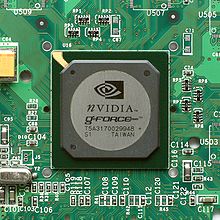Preview lessons, content and tests
Computer Science & Programming solved. All in one platform.
1. To trial the platform and take tests, please take a few seconds to SIGN UP and SET UP FREE.2. Searching for something specific? See our text overview of all tests. Scroll right for levels, and lists. 3. Student and Teacher User Guides | Schemes of Work | Real Teacher use Videos |
Join 36000+ teachers and students using TTIO.
GPUs and their uses
Did you know - GeForce 256 was marketed as "the world's first 'GPU', or Graphics Processing Unit", a term Nvidia defined at the time as "a single-chip processor with integrated transform, lighting, triangle setup/clipping, and rendering engines that is capable of processing a minimum of 10 million polygons per second."

GeForce 256 (NV10) GPU (above)
A GPU, or graphics processing unit, is used primarily for 3D applications. It is a single-chip processor that creates lighting effects and transforms objects every time a 3D scene is redrawn. These are mathematically-intensive tasks, which otherwise, would put quite a strain on the CPU.
Additional Resources
https://www.boston.co.uk/info/nvidia-kepler/what-is-gpu-computing.aspx
https://en.wikipedia.org/wiki/Graphics_processing_unit
https://searchvirtualdesktop.techtarget.com/definition/GPU-graphics-processing-unit
https://www.omnisci.com/technical-glossary/cpu-vs-gpu
Difference between CPU and GPU
The main difference between CPU and GPU architecture is that a CPU is designed to handle a wide-range of tasks quickly (as measured by CPU clock speed), but are limited in the concurrency of tasks that can be running. A GPU is designed to quickly ender high-resolution images and video concurrently.
Because GPUs can perform parallel operations on multiple sets of data, they are also commonly used for non-graphical tasks such as machine learning and scientific computation. Designed with thousands of processor cores running simultaneously, GPUs enable massive parallelism where each core is focused on making efficient calculations.


